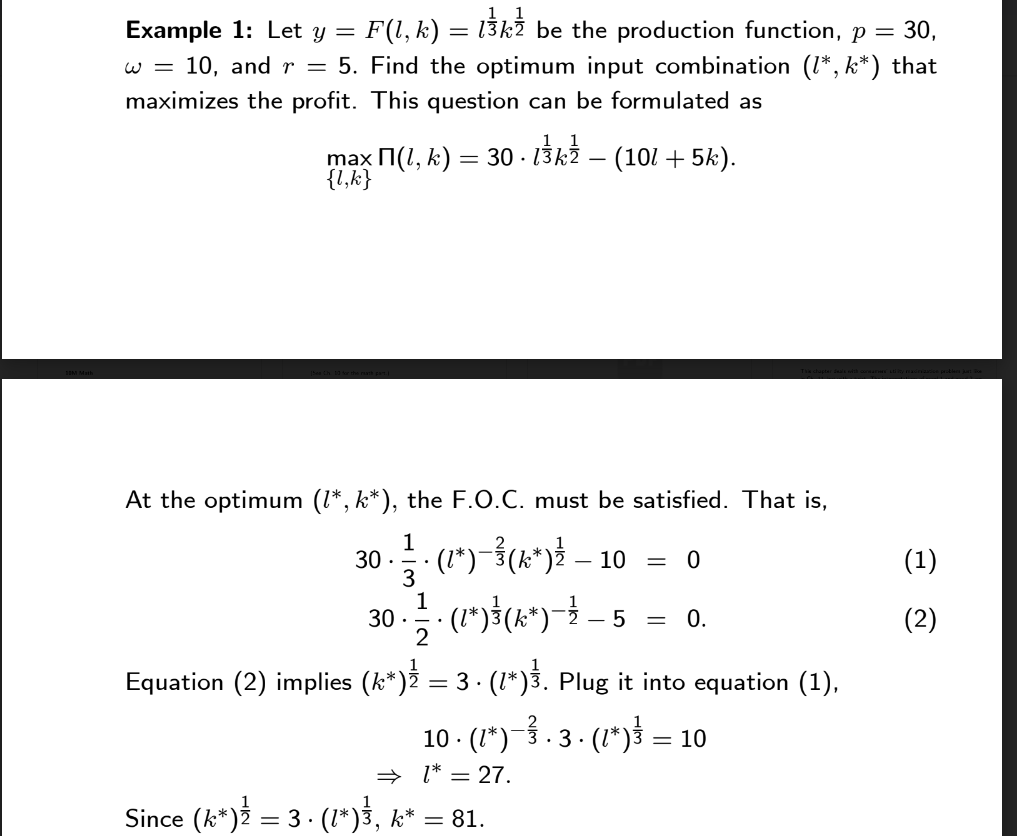1 Example 1: Let y = F(l, k) = 13k2 be the production function, p = 30, w = 10, and r = 5. maximizes the profit. Find the optimum input combination (l*, k*) that This question can be formulated as max M(1, k) = 30 - l¾kź – (101 + 5k). {l,k} At the optimum (l*, k*), the F.O.C. must be satisfied. That is, 1 30. · (1*)−¾(k*)} – 10 = 0 . - 3 30 - 1/2 · (²*) }(k*)———5 = 0. - Equation (2) implies (k*)} = 3 ⋅ (1*)¾. Plug it into equation (1), 10 () 3.3 (1) 10 · ³ = . ⇒ 1* = 27. · Since (k*)¹ = 3 ⋅ (1*)¾, k* = 81. (1) (2)
1 Example 1: Let y = F(l, k) = 13k2 be the production function, p = 30, w = 10, and r = 5. maximizes the profit. Find the optimum input combination (l*, k*) that This question can be formulated as max M(1, k) = 30 - l¾kź – (101 + 5k). {l,k} At the optimum (l*, k*), the F.O.C. must be satisfied. That is, 1 30. · (1*)−¾(k*)} – 10 = 0 . - 3 30 - 1/2 · (²*) }(k*)———5 = 0. - Equation (2) implies (k*)} = 3 ⋅ (1*)¾. Plug it into equation (1), 10 () 3.3 (1) 10 · ³ = . ⇒ 1* = 27. · Since (k*)¹ = 3 ⋅ (1*)¾, k* = 81. (1) (2)
Chapter9: Production Functions
Section: Chapter Questions
Problem 9.7P
Related questions
Question
This is not a graded question. Kindly help me solve.
This is a question from my lecture notes. I want to understand the steps involed in arriving at the anwer shown. Kindly explain all steps showing details of how the answer was arrived at. Please don't use langrangian law. Thanks a lot.

Transcribed Image Text:Example 1: Let y = : F(l, k) = l¾kỄ be the production function, p = 30,
w = 10, and r = 5. Find the optimum input combination (1*, k*) that
maximizes the profit. This question can be formulated as
max П(l, k) = 30 · l¾kź – (101 + 5k).
{l,k}
At the optimum (1*, k*), the F.O.C. must be satisfied. That is,
1
30. · (1*) −¾ (k*) ¾ — 10
3
30. • 1/2 · (²*) ³} (x^³*) — — — 5 = 0.
Equation (2) implies (k*)
= 0
= 3 ⋅ (1*)³. Plug it into equation (1),
.
10 · (1*)−³ · 3 · (1*) — 10
⇒ 1* = 27.
Since (k*) = 3 ⋅ (1*)³, k* = 81.
(1)
(2)
Expert Solution
This question has been solved!
Explore an expertly crafted, step-by-step solution for a thorough understanding of key concepts.
Step by step
Solved in 3 steps with 3 images

Knowledge Booster
Learn more about
Need a deep-dive on the concept behind this application? Look no further. Learn more about this topic, economics and related others by exploring similar questions and additional content below.Recommended textbooks for you


Managerial Economics: Applications, Strategies an…
Economics
ISBN:
9781305506381
Author:
James R. McGuigan, R. Charles Moyer, Frederick H.deB. Harris
Publisher:
Cengage Learning



Managerial Economics: Applications, Strategies an…
Economics
ISBN:
9781305506381
Author:
James R. McGuigan, R. Charles Moyer, Frederick H.deB. Harris
Publisher:
Cengage Learning



